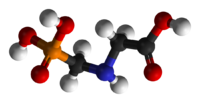
Photo from wikipedia
Sonchus oleraceus is becoming a hard-to-control weed in Australian cropping systems, especially in glyphosate-tolerant cotton and during summer fallows. Several biotypes of this weed have developed resistance to glyphosate as… Click to show full abstract
Sonchus oleraceus is becoming a hard-to-control weed in Australian cropping systems, especially in glyphosate-tolerant cotton and during summer fallows. Several biotypes of this weed have developed resistance to glyphosate as a result of common management practices under conservation agriculture systems in the country. A series of pot experiments were conducted to evaluate the effect of temperature on glyphosate efficacy and performance of several post-emergence and pre-emergence herbicides on a glyphosate-resistant (GR) and a glyphosate-susceptible (GS) biotype of S. oleraceus. At low temperatures (19–24 °C), no plants of the GS biotype survived glyphosate application at 570 g/ha; however, in the high-temperature regime (28–30 °C), 83% of the plants survived this rate of glyphosate. Similarly, for the GR biotype, up to 58% of the plants survived at 2280 g/ha of glyphosate when applied during the high-temperature regime and no plants survived this rate during the low-temperature regime. A number of post-emergence herbicides were found to be effective for S. oleraceus control. However, herbicide application delayed to the six-leaf stage compared with the four-leaf stage reduced control, especially for bromoxynil and saflufenacil herbicides. Glufosinate and paraquat were the most effective herbicides for S. oleraceus control, resulting in no seedling survival for both biotypes. Isoxaflutole, pendimethalin or s-metolachlor efficacy was not reduced by the presence of crop residue, suggesting that these herbicides could be used to control S. oleraceus in conservation agriculture systems. The results of this study suggest that growers will need to reduce over-reliance on glyphosate for weed control in summer fallows and use alternative post-emergence herbicides.
Journal Title: Sustainability
Year Published: 2020
Link to full text (if available)
Share on Social Media: Sign Up to like & get
recommendations!